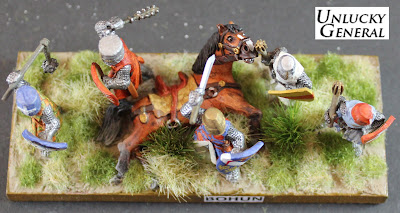TABLE-TOP: Building Part 2
Having fine but cold weather these past few days has enabled me to complete my Downs of Lewes to the sanding stage. I have completed all eight levels of the Styrofoam construction, being mindful to return and justify the sides repeatedly. They need to be a near to perfectly square as I can make them, requiring re-shaving and sanding back each time a new layer is added .
As you can see, it looks quite the colossus in pure white and for the time being my car has taken up residence on the drive. The dots in the mid-left quadrant are figures from my Lewes collection to give some idea of scale. There was a time early in this build that I pondered whether to add another 300mm to the left of this shot (another half tile width) but then decided against it. The table is big enough and players need to be able to reach into the middle from at least one side.
I moved straight on to the chamfering stage and started out with a hot-wire cutter - this time a hand held 'Polylon' cutter which I bought on-line. It was about AUD25.00 and is battery operated. Whilst it was effective, the wire is not that hot and a very thin gauge and simply took ages to cut along the slopes. It would be best for foam sculpting and smaller cutting jobs. After losing my wire twice, I lost patience with it and resorted to cutting them off with my trusty hand saw. Much quicker but very, very messy. I'm no stranger to working with foam; however, so had my trusty vacuum cleaner on standby throughout the process.
I also abandoned the pinning solution for shifting tiles. The thickness of the ply base boards (9mm) doesn't really allow for pinning with anything other than the flimsiest of dowels. Instead, I'll use a Velcro solution which the tiles can sit on. I was about to get stuck into the sanding phase immediately but having already taken one trip to the home hardware store, I was not inclined to go back this afternoon for sand-paper. I could have sworn I had some!
I really want to 'uneven' the flat surfaces and blend the slopes into the terrain as much as possible. A tip for anyone else trying this sort of application of map to terrain is to go for as detailed a map as possible. I could have used a more refined contour pattern with more contours at lesser intervals than 50'. As you can see, my map has provided for large gaps between each level which don't exist in the real world. A good sanding and the use of teddy-bear fur for my ground covering should assist greatly in merging this structured look to the landscape - at least I hope so. When I do this in future, I'll definitely go for thinner foam but more levels.
As you can see, it looks quite the colossus in pure white and for the time being my car has taken up residence on the drive. The dots in the mid-left quadrant are figures from my Lewes collection to give some idea of scale. There was a time early in this build that I pondered whether to add another 300mm to the left of this shot (another half tile width) but then decided against it. The table is big enough and players need to be able to reach into the middle from at least one side.
I moved straight on to the chamfering stage and started out with a hot-wire cutter - this time a hand held 'Polylon' cutter which I bought on-line. It was about AUD25.00 and is battery operated. Whilst it was effective, the wire is not that hot and a very thin gauge and simply took ages to cut along the slopes. It would be best for foam sculpting and smaller cutting jobs. After losing my wire twice, I lost patience with it and resorted to cutting them off with my trusty hand saw. Much quicker but very, very messy. I'm no stranger to working with foam; however, so had my trusty vacuum cleaner on standby throughout the process.
I also abandoned the pinning solution for shifting tiles. The thickness of the ply base boards (9mm) doesn't really allow for pinning with anything other than the flimsiest of dowels. Instead, I'll use a Velcro solution which the tiles can sit on. I was about to get stuck into the sanding phase immediately but having already taken one trip to the home hardware store, I was not inclined to go back this afternoon for sand-paper. I could have sworn I had some!
I really want to 'uneven' the flat surfaces and blend the slopes into the terrain as much as possible. A tip for anyone else trying this sort of application of map to terrain is to go for as detailed a map as possible. I could have used a more refined contour pattern with more contours at lesser intervals than 50'. As you can see, my map has provided for large gaps between each level which don't exist in the real world. A good sanding and the use of teddy-bear fur for my ground covering should assist greatly in merging this structured look to the landscape - at least I hope so. When I do this in future, I'll definitely go for thinner foam but more levels.






Comments
cheers
Matt